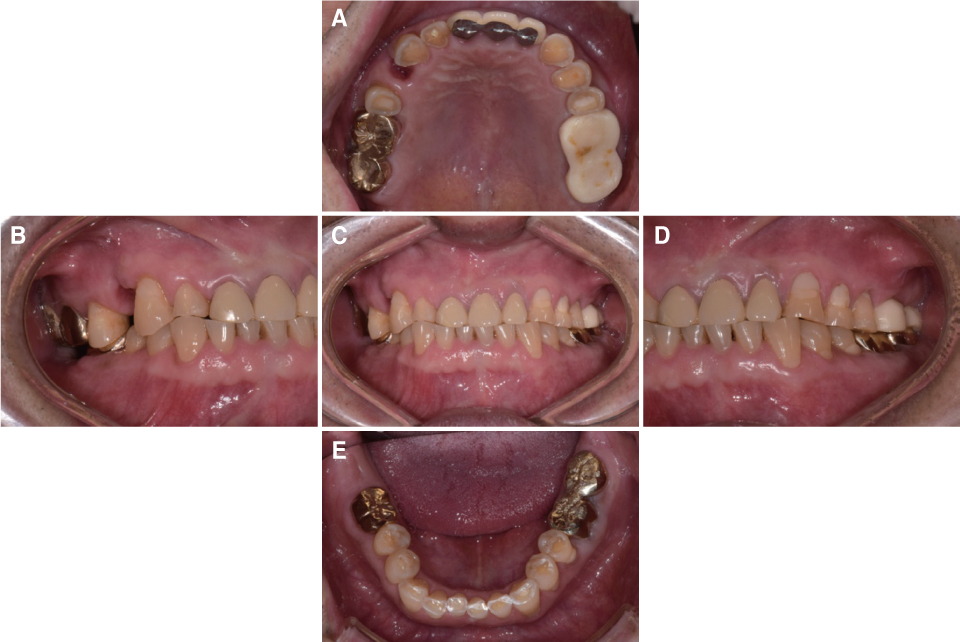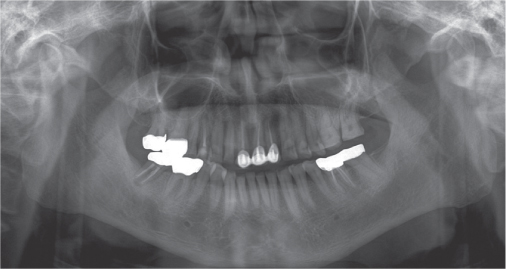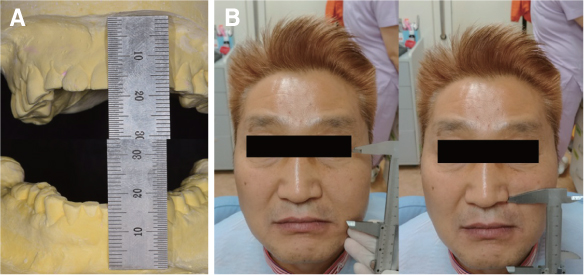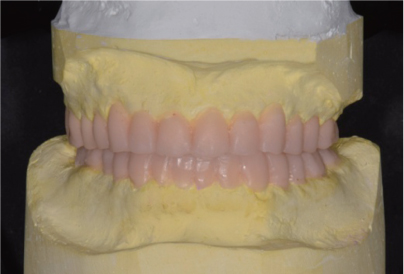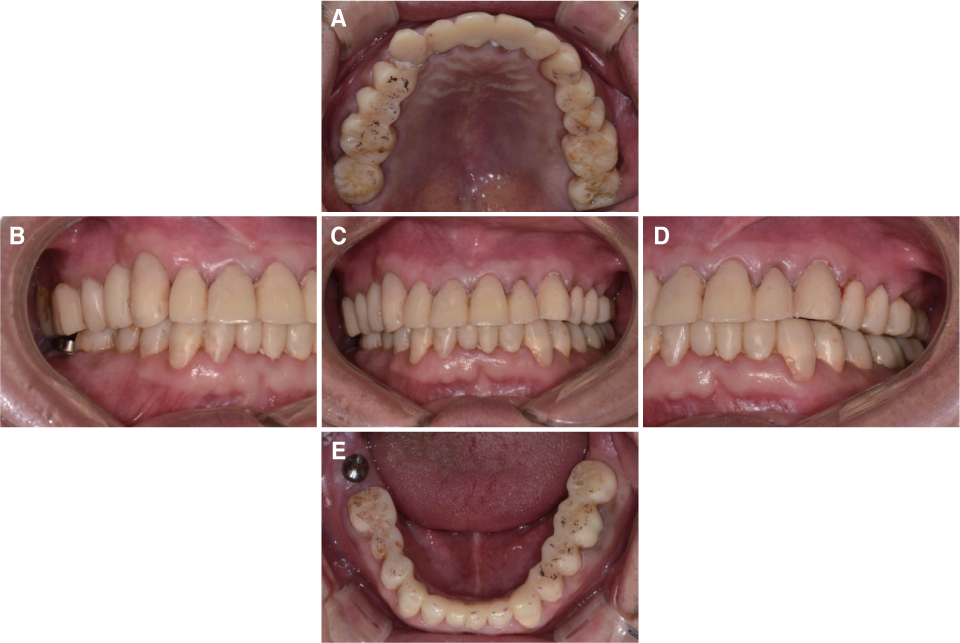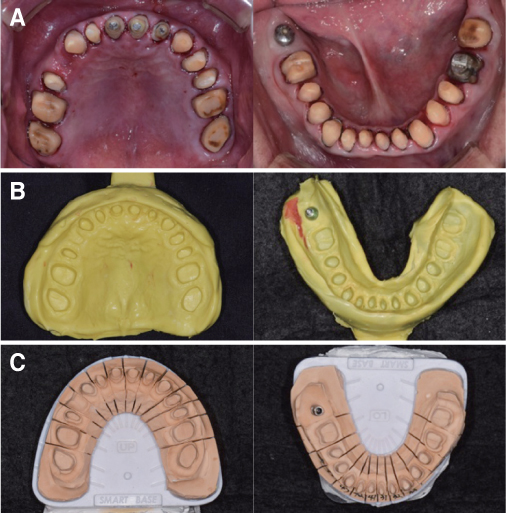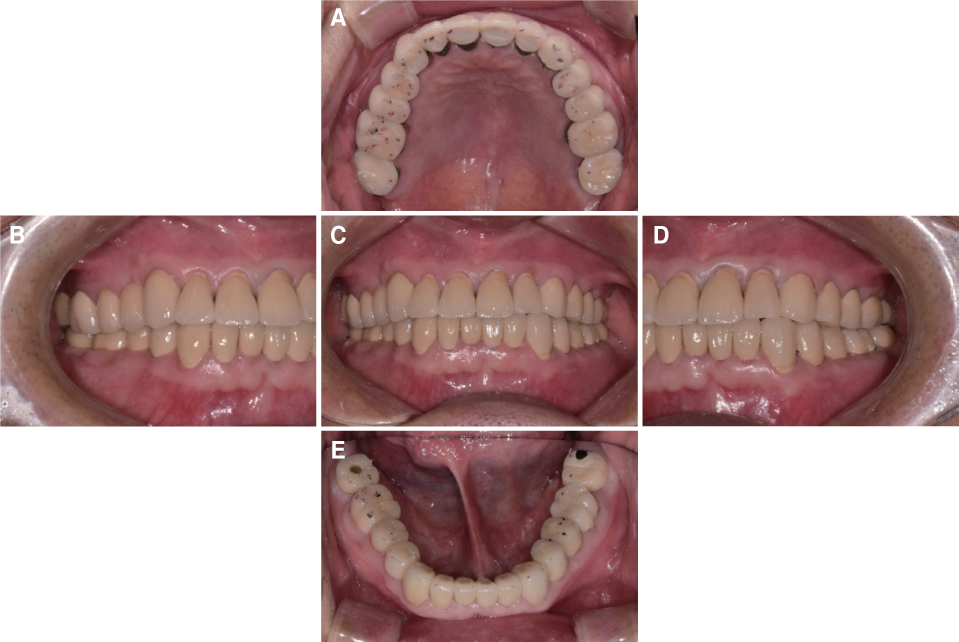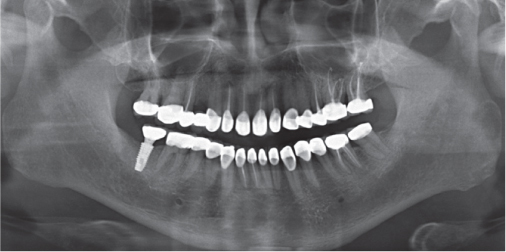J Korean Acad Prosthodont.
2019 Jan;57(1):49-56. 10.4047/jkap.2019.57.1.49.
Complete mouth rehabilitation with vertical dimension increase in patient with extremely worn dentition
- Affiliations
-
- 1Department of Prosthodontic Dentistry, Veterans Health Service Medical Center, Seoul, Republic of Korea. ilovedua@naver.com
- KMID: 2432002
- DOI: http://doi.org/10.4047/jkap.2019.57.1.49
Abstract
- Generalized severely worn dentition causes occlusal disharmony, esthetic problems, and temporomandibular joint disorders. In order to solve these problems, it is necessary to make a precise analysis of vertical dimension and treatment plans considering it. This case report demonstrates the complete mouth rehabilitation of a 58-year-old male patient with a lot of worn teeth by increasing vertical dimension. Provisional restorations were cemented and after 4 months of evaluation for patient's compliance, permanent prostheses were fabricated. With these treatments, functionally and esthetically satisfactory results were obtained.
MeSH Terms
Figure
Reference
-
1. Murphy T. Compensatory mechanisms in facial height adjustment to functional tooth attrition. Aust Dent J. 1959; 4:312–323.
Article2. Rivera-Morales WC, Mohl ND. Relationship of occlusal vertical dimension to the health of the masticatory system. J Prosthet Dent. 1991; 65:547–553.
Article3. Briggs P, Bishop K. Fixed prostheses in the treatment of tooth wear. Eur J Prosthodont Restor Dent. 1997; 5:175–180.4. Hemmings KW, Darbar UR, Vaughan S. Tooth wear treated with direct composite restorations at an increased vertical dimension: results at 30 months. J Prosthet Dent. 2000; 83:287–293.
Article5. Sato S, Hotta TH, Pedrazzi V. Removable occlusal overlay splint in the management of tooth wear: a clinical report. J Prosthet Dent. 2000; 83:392–395.
Article6. Dahl BL, Krogstad O. The effect of a partial bite-raising splint on the inclination of upper and lower front teeth. Acta Odontol Scand. 1983; 41:311–314.
Article7. Ramfjord SP, Blankenship JR. Increased occlusal vertical dimension in adult monkeys. J Prosthet Dent. 1981; 45:74–83.
Article8. Dawson PE. Functional occlusion: From TMJ to smile design. St. Louis: Mosby Elsevier;2007. p. 430–452.9. Turner KA, Missirlian DM. Restoration of the extremely worn dentition. J Prosthet Dent. 1984; 52:467–474.
Article10. Willis FM. Features of the face involved in full denture prosthesis. Dent Cosmos. 1935; 77:851–854.11. Silverman MM. The speaking method in measuring vertical dimension. J Prosthet Dent. 2001; 85:427–431.
Article12. Park JH, Jeong CM, Jeon YC, Lim JS. A study on the occlusal plane and the vertical dimension in Korean adults with natural dentition. J Korean Acad Prosthodont. 2005; 43:41–51.13. Rivera-Morales WC, Mohl ND. Restoration of the vertical dimension of occlusion in the severely worn dentition. Dent Clin North Am. 1992; 36:651–664.14. Verrett RG. Analyzing the etiology of an extremely worn dentition. J Prosthodont. 2001; 10:224–233.
Article15. Jagger DC, Harrison A. An in vitro investigation into the wear effects of selected restorative materials on enamel. J Oral Rehabil. 1995; 22:275–281.
Article16. Lussi A. Dental erosion clinical diagnosis and case history taking. Eur J Oral Sci. 1996; 104:191–198.
Article17. Jacobi R, Shillingburg HT Jr, Duncanson MG Jr. A comparison of the abrasiveness of six ceramic surfaces and gold. J Prosthet Dent. 1991; 66:303–309.
Article18. Dahl BL, Carlsson GE, Ekfeldt A. Occlusal wear of teeth and restorative materials. A review of classification, etiology, mechanisms of wear, and some aspects of restorative procedures. Acta Odontol Scand. 1993; 51:299–311.
Article19. Abduo J, Lyons K. Clinical considerations for increasing occlusal vertical dimension: a review. Aust Dent J. 2012; 57:2–10.
Article
- Full Text Links
- Actions
-
Cited
- CITED
-
- Close
- Share
- Similar articles
-
- Full-mouth rehabilitation without changing the vertical dimension in patient with worn dentition
- Full mouth rehabilitation with extremely worn dentition
- Full mouth rehabilitation using zirconia crown in severe worn dentition: a case report
- Full mouth rehabilitation with vertical dimension increase in patient with loss of anterior guidance due to maxillary anterior teeth wear: A case report
- Mouth rehabilitation of a patient with severely worn dentition with vertical dimension increase


